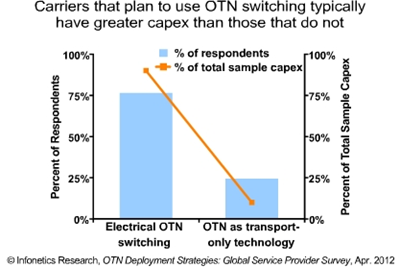マサチューセッツ州ボストン 2012年5月2日 マーケット調査会社インフォネティクスリサーチは、新たなOTN開発戦略(Optical Transport Network Strategies):グローバルサービスプロバイダーの調査からの抜粋記事を発表したが、この記事の中では、世界の通信産業の3分の1を超える収益と資本支出を占めるサービスプロバイダー21社を対象に、アナリストがインタビューをおこなっている。

この調査では、さまざまな問題に対して答えを導き出そうとしている。つまり、メトロやコアノード内でOptical Transport Networkスイッチングがどの程度利用されるか、どのくらいのサイズのスイッチが必要か、どのように管理するのか、どのサイズのOTNスイッチング構造が必要か、ODU-flexは必要な機能か、そして一般的にいって、キャリアにどの程度の収益が見込めるのか、伝達技術としてすでにどの程度設置が進んでいるのか、などなどといった問題である。
アナリストノート
"「私たちがおこなったOTN開発戦略の調査では、OTNスイッチングはほとんどの地域ネットワーク、長距離ネットワークで主導的で重要な役割を担うことが予想されます。しかし、すべてのキャリアに当てはまるわけではありません」と、インフォネティクスリサーチで光学部門の主任アナリストをつとめるAndrew Schmittは述べている。
「レイヤー2スイッチ機能をOTNハードウェアーに統合するかはまだ合意に至っていないし、その見込みもありません。しかし、少し驚いたことに、いわゆる『厳格なOSI信奉者』の陣営に属するキャリアの中には、L0+L1+L2統合ソリューションの採用に興味を示すところもあります」
Schmitt氏はさらに述べる。「もっとも注目すべきなのは、私たちがインタビューしたサービスプロバイダーのうちおよそ4分の3が、OTNスイッチの設置を計画しているということです。このサンプルは回答者の資本支出の90%を示しており、光学部門での予算のほとんどは、OTNスイッチングを扱うキャリアによって使わることを意味しています」
その他OTN調査のハイライト
- 現在使用している、また将来使用予定のメトロOTNポートは増加傾向である。
- 波長効率は依然としてOTNのキーとなるアプリケーションだが、サービスプロバイダーはOTNスイッチング開発の一部として、さらに高度なマネージメントコントロール水準を展開している。
- ODU-flexはハーウェイのユーザーにとって重要である。
- インフォネティクスが最近発表したリポートOTNハードウェアマーケットの展望によると、OTNスイッチングとトランスポートハードウェアに費やされる額は、2011年前期における全世界の光学部門での設備投資額の45%を占めており、2015年までには70%、もしくは106億ドルまでに増え、成長速度はOTNトランスポートよりもOTNスイッチングの方がはるかに速いと見込まれている。
Operators confirm transition to OTN switching is underway
BOSTON, Massachusetts, May 2, 2012-Market research firm Infonetics Research released excerpts from its new OTN Deployment Strategies: Global Service Provider Survey, for which its analysts interviewed 21 service providers from around the world that together represent over a third of global telecom revenue and capex. The survey set out to answer questions such as how much Optical Transport Network switching will be used in metro and core nodes, what size these switches need to be, how they will be managed, size requirements of OTN switch fabrics, whether ODU-flex is an important feature, and in general, the level of carrier interest in OTN and to what degree it is already deployed as a transport technology.
ANALYST NOTE
"The results of our OTN Deployment Strategies survey show that OTN switching will play a leading and significant role in the regional and long haul networks of most, but not all carriers," states Andrew Schmitt, principal analyst for optical at Infonetics Research. "There is no agreement (nor will there likely ever be) on whether layer 2 switching features should be combined into OTN hardware, but a few carriers we thought were in the 'strict OSI segregationist' camp now show interest in embracing unified L0+L1+L2 solutions-a bit of a shock!"
Schmitt adds: "Most notable is the fact that about three-quarters of the service providers we interviewed plan to deploy OTN switching-this sample represents 90% of all respondent capex, which means most optical dollars will be spent by carriers with OTN switching."
ADDITIONAL SELECT OTN SURVEY HIGHLIGHTS
- Current and projected use of metro OTN ports is increasing
- Wavelength efficiency remains the key application for OTN, but service providers are rolling out more sophisticated management control planes as part of OTN switching deployments
- ODU-flex is important to a small base of mostly Huawei customers
- Infonetics' recent OTN Hardware Market Outlook report shows that OTN switching and transport hardware together made up 45% of global optical equipment spending in the first half of 2011, and is expected to grow to 70% of the total by 2015, or $10.6 billion, with OTN switching growing much faster than OTN transport.

